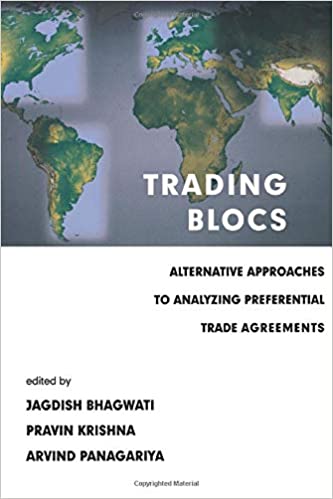Trading Blocs: Alternative Approaches to Analyzing Preferential Trade Agreements
(edited with J. Bhagwati and Pravin Krishna)
(Cambridge, MA: MIT Press, February 1999)

This volume will enable graduate students, scholars of PTAs, and policymakers concerned with trade liberalization to grasp the analytical relationships among the sometimes disparate contributions of nearly a half century of theoretical research on PTAs.The recent proliferation of free trade areas and customs unions in the world trading system has led to an explosive revival of interest in the economic analysis of Preferential Trade Arrangements (PTAs). The principal theoretical question of the 1950s and 1960s (Viner) was whether PTAs would create or divert trade, causing welfare improvement or loss. The principal theoretical question (Bhagwati) of the late 1980s and 1990s has been whether PTAs encourage or discourage the worldwide nondiscriminatory freeing of trade. The essays in this volume present the central contributions to the analytical approaches developed to examine these questions.The first section of the book presents a synthesis and analytical guide to the issues, and to the theoretical research, as they have developed since 1950. The following sections contain the theoretical contributions themselves, grouped by analytical approach. This volume will enable graduate students, scholars of PTAs, and policymakers concerned with trade liberalization to grasp the analytical relationships among the sometimes disparate contributions of nearly a half century of theoretical research on PTAs.ContributorsRichard Baldwin, Jagdish Bhagwati, Richard Brecher, C. A. Cooper, W. Max Corden, Alan Deardorff, Ronald Findlay, Earl Grinols, Gene Grossman, Elhanan Helpman, Harry G. Johnson, Murray C. Kemp, Pravin Krishna, Paul Krugman, Philip Levy, R. G. Lipsey, B. F. Massell, Robert Mundell, Arvind Panagariya, Martin Richardson, T. N. Srinivasan, Robert Stern, Lawrence Summers, Jacob Viner, Henry Y. Wan, Jr.